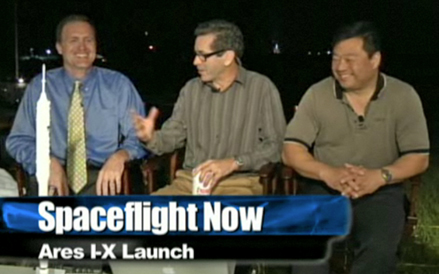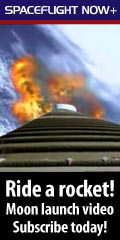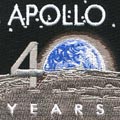The Ares 1-X Experience:
From Penguins to Popes

The launch of a brand new rocket that could be part of the United States' future manned space program brought our Spaceflight Now team together with more than 100,000 of you across the world. Viewers in almost every country "tuned in" to watch history and see if this rocket would succeed or fail. Even folks in Antarctica and Vatican City watched our channel. From penguins to popes, the global community was riveted. These are the observations of our Spaceflight Now video team.
Send us your feedback about our live launch show at feedback2009@spaceflightnow.com or by clicking our names below.
 Miles O'Brien (center), David Waters (left), and astronaut Leroy Chiao anchor Spaceflight Now's live interactive coverage of the Ares 1-X launch. Credit: Roger Scruggs
Miles O'Brien (center), David Waters (left), and astronaut Leroy Chiao anchor Spaceflight Now's live interactive coverage of the Ares 1-X launch. Credit: Roger Scruggs
When I appeared at the KSC badging office on State Route 3 at 0430, I was reminded this is not your father's spacemobile. The women behind the counter asked if I was there to cover the launch of that "lawn dart." Indeed, the Ares 1-X is so tall and skinny it could audition for "America's Next Top Model."
But this model rocket does not have a guaranteed place on the runway. In fact, it is hard to say if this launch is analogous to the first flight of The Saturn 1 (which flew 48 years and one day prior) – the dawn of a new era – or the Spruce Goose – a one-off historical footnote. But the team, rightly, did not seem to be rattled at all by the uncertainties. They built it, stacked it, rolled it out – and then waited for a patch of blue in the passing clouds before lighting the candle.
The next day, I was with NASA Administrator Charlie Bolden as he addressed the meeting of the NASA Advisory Council at NASA's Ames Research Center. As he spoke about the launch, he broke up – reminding us "we don't do this every day." Ares 1 may face its own cloudy path – but I see a patch of blue: the passion to keep pushing – and the willingness to take risks on the way – is still alive. Making it means those of us who care about expanding the boundaries of the final frontier must commit ourselves to doing some evangelizing. Our new rockets may be skinny, but if we truly wish to leave low earth orbit, the budgets cannot be as lean as they are.
Eyeballs around the world watched this brand new rocket with us to see what it would do. Was it going to be a success, a failure, or something in between? The first launch attempt was riveting. A cargo ship strayed into the launch hazard area, postponing launch while the captain was asked to turn the ship around. Then a pesky Velcro cover that protected sensors from rain at the top of the rocket wouldn’t budge when workers tried to pull it off. It was so high up, the only way to pull it off was a lanyard hooked to it. It was old fashioned tug of war and the rocket was winning. Then woosh, the cover lost, the workers won. But cloudy weather won the day and delayed the launch.
Teacher Leslie Carmichael wrote that the drama wasn’t just a local phenomenon amongst rocket watchers. She said some elementary school students in North Carolina took their lunches back to their classroom so they could watch. “I did want you to know that you had a few hundred elementary students at Wesley Chapel Elementary School in Monroe, NC, enjoying your live feed.”
The next day, launch seemed just as iffy. Launch controllers constantly adjusted liftoff time looking for an opening in the clouds. They got it. We stopped talking and listened in to launch control. Leroy and I got out of our seats in our broadcast tent and stretched out our microphone cables so we could watch this new spacecraft launch. I turned into tourist and broke out my own camera to get video and stills of this new rocket launching.
Ares I-X tore away from the pad on a trail of fire. The crackling we heard from the press site was loud, and on par with a shuttle launch with a little less bass. It also left a burn in my eyes for a few minutes because the trail was so bright. The data that was beamed back will pave the way for future astronauts riding rockets to space. The question is, what will they fly, and where will they go? That critical decision is in the hands of the White House now and will decide if we fall behind, or maintain our leadership in space. That depends on folks like you reading this who will have to let political leaders know if that is important to you.
 ATK's Jim Halsall, Miles O'Brien and Leroy Chiao talk on air prior to the launch of Ares 1-X.
ATK's Jim Halsall, Miles O'Brien and Leroy Chiao talk on air prior to the launch of Ares 1-X.
As the final seconds ticked away, I momentarily found myself back inside of Space Shuttle Columbia, waiting for my first launch. The rocket leapt off of the pad, leaving the familiar white cloud behind. What would it be like sitting atop of this rocket? I remembered the kick at T-0, the vibration of first stage, how I could barely read the screens. The noise reached us at the viewing site. I heard the crackle and popping that one doesn't hear inside. I snapped back to the present, watching the rocket continue its skyward arc.
I felt a sudden tinge of sadness, remembering that there were only six more Space Shuttle flights left. Even with her flaws, the Shuttle is a beautiful, magnificent flying machine, a technological marvel of her time. I will miss her.
What will the future bring? How will American astronauts fly to space? This is an uncertain time, but I am hopeful that the United States will remain the leader in human spaceflight.
I'm not sure what I was expecting for this launch – "Shuttle Lite," perhaps. After all, the Ares I-X rocket was the equivalent of one shuttle Solid Rocket Booster, with a dummy upper-stage stacked on top. I've seen about 15 shuttle launches, each complete with TWO SRB's plus the shuttle's main engines. So, hey, whatever the Ares I-X launch was going to look like, it had to be a shadow of Shuttle, right? Wrong.
When people ask me, I always say a shuttle launch is a three-fer. First you see it lift off the pad, completely silent. Then a few seconds into it, you hear it – it builds like a bass roar, like someone turned the volume on the stereo down, cranked the bass up as high as it will go, and then slowly turned the sound up. And then you feel it – a pressure wave that hits you like a hot wind in the face, growing so intense your teeth almost start to chatter. And the fire coming out of the business end of the rocket! It is as bright as staring at the sun...tear stream down my face as I look at it and try not to turn away.
Well, Ares I-X matched shuttle step for step...maybe even more intense (if that is possible!). And the sight of it! Shuttles launching on a rendezvous trajectory to the International Space Station take off and head northeast across the Atlantic. From our viewing point at the Kennedy Space Center Press Mound, they seem to arc away from you. But Ares I-X, on a more easterly trajectory, seemed to arc across the sky from left to right in a grand sweep that we could follow for what seemed liked ages (though it was only a few minutes).
It was a heart-in-the-throat experience. Was it the start of a new era in manned spaceflight, or a one-off "streak across the sky" for a rocket that is not meant to be? I don't have a crystal ball on that. The ball is in the Obama Administration's court. Whatever the future holds, I was unexpectedly stirred by this launch. It there was a sense of hope and possibility in the air that is just plain missing as the shuttle program winds down. It was just different. A good different.
As for our webcast on launch day, I'm one of the folks behind-the-scenes, trying to keep the show online and the trains running on time. I was absolutely thrilled with our production this time around – I really think we are hitting our stride now. I'm looking forward to our STS-129 coverage on November 16! It is hard to believe there are only six more missions left in the shuttle program...each orbiter will fly two more times. And then, no matter what, there will be a gap – probably a long one – before the U.S. is flying our astronauts to space on our own vehicles again. I'm on the edge of my seat: will there be an Ares I-Y?



 Miles O'Brien (center), David Waters (left), and astronaut Leroy Chiao anchor Spaceflight Now's live interactive coverage of the Ares 1-X launch. Credit: Roger Scruggs
Miles O'Brien (center), David Waters (left), and astronaut Leroy Chiao anchor Spaceflight Now's live interactive coverage of the Ares 1-X launch. Credit: Roger Scruggs
 ATK's Jim Halsall, Miles O'Brien and Leroy Chiao talk on air prior to the launch of Ares 1-X.
ATK's Jim Halsall, Miles O'Brien and Leroy Chiao talk on air prior to the launch of Ares 1-X.
